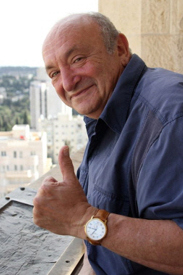FIE Tactile
The Tactile Program
By Prof. Roman Gouzman, Ph.D.
 Why it is worthwhile to choose the Tactile-Kinesthetic program?
Why it is worthwhile to choose the Tactile-Kinesthetic program?
This program was conceived by Professor Reuven Feuerstein and subsequently developed by Professor Roman Gouzman.
Roman Gouzman (“Tactile Papa”) was the Head of Tactile Instrumental Enrichment Department at the Feuerstein Institute during 30 years. An expert in the Multi-Sensory approach for ADHD and blind learners, Professor Gouzman is the creator of the Tactile Mediated Learning and Tactile Instrumental Enrichment tools. As well, he has pioneered methods to improve focusing and developing of adequate mental imaging in ADHD learners. Professor Gouzman is a member of a number of scientific organizations and a creative inventor. He has been awarded the European IST first prize for VirTouch, a computer screen-mouse for the blind users, and holds three patents in the United States and Europe.
“Touch” and “Movement” are the main senses used in the Tactile-Kinesthetic Program.
Perhaps the most overarching objective of the FIE T-K program for blind and visually impaired learners is to overcome the lack of visual stimuli to develop images and concepts. In the program, the modality of “touch” (tactile, kinesthetic, haptic) substitutes for visualization and thus contributes to conceptual imaging.
In the case of the ADHD population, the most overarching objective of the FIE T-K program is to “slow down” the attention deficit learner, to “convert” him/her into a systematic explorer, who plans activities and is aware of each stage in the learning process.
One of the most overarching objectives for Tactile-Kinesthetic mediators is to be cognizant of the learner’s thinking at all stages of the learning process.
In regular cognitive instruments, the mediator receives information about the learner’s cognitive processing only in the output phase.
By contrast, in the Tactile Instrumental Enrichment (IE), the mediator has full access to the learner’s hidden cognitive processing in each of the phases (input, elaboration and output).
With every movement of the fingers and the palm, “touch” shows us hidden cognitive processes. The mediator notes the learner’s starting point, as well as the processes of trial and error, impulsivity, precision, orientation in space and time.
The tactile procedure can show the mediator all the learner’s strategies and cognitive functions “online.” The mediator also notes whether or not the student follows a particular strategy. In the tactile modality each movement of the learner reveals to the mediator whether he/she explores in a systematic or unsystematic manner.
In the tactile mode, the learning process can be seen as well in the input phase and during the elaboration phase.
We name it “a miracle of Tactile-Kinestchetic MRI observation”! (“Tactile-Kinestetic MRI”)
Mental imaging: Release from the slavery of visual perception
We build a multi-sensory substitution system comprised of touch, sound and motion. These are the key factors in increasing spatial ability, expanding the mental image “library” and enhancing the conceptualization of hidden relations.
Mental imaging for ADHD learners:
We build a tactile-kinesthetic focusing approach, based on mental imaging. This helps the learner to ignore irrelevant details, be precise, discover hidden relations and better conceptualize.
There are several important sub-goals of Tactile-Kinesthetic. But two of them are essential: 1) to “convert” learner into a systematic, independed explorer, who plans activities and is aware of each stage in the learning process and 2) Having fun!
